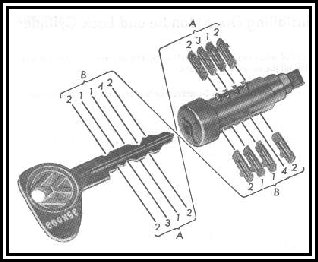| Unlocking the Mystery of VW Locks by Dave Hall (1997) |
|
The barrel contains 8 pieces of brass with slots, called tumblers (9 in the ignition switch barrel) and 8 (or 9) tiny springs to push them out. Each tumbler has 0, 1, 2 or 3 notches on its end, which is a code telling you how long the cut out slot is (matching 1,2,3 and 4 in the picture). The right key pulls in all the tumblers flush with the barrel, but the wrong key leaves some or all sticking out a bit, which prevents the barrel turning. Check the diagram (from official manuals, thanks VW!) carefully, to see how the key shape matches the tumbler slots. This is the key (sorry!) to changing the tumblers to match your other locks. Door locks are easy, and you can pull apart old barrels to get the right tumblers. According to VW, ignition and tail-gate barrels cannot be standardised. The latter are pinned in place and could be damaged by removal, I guess, but I'll try it one day! If you need a key cut, your (long-established) VW dealer may have the code books to tell him what shape your key is from the number on the lock (stamped on the handle mechanism). Mine can do it, but maybe I'm lucky! If you change the barrel, paint out the old one and mark on the new number! |
 All the Type
3 and Type 4 (and many Beetle/Bus too) door lock barrels are similar,
but their overall size differs, as does the profile of the key (the
grooves along its length). This changed from time to time, to
increase the possible number of key combinations. For key profiles
read the August 1997
All the Type
3 and Type 4 (and many Beetle/Bus too) door lock barrels are similar,
but their overall size differs, as does the profile of the key (the
grooves along its length). This changed from time to time, to
increase the possible number of key combinations. For key profiles
read the August 1997